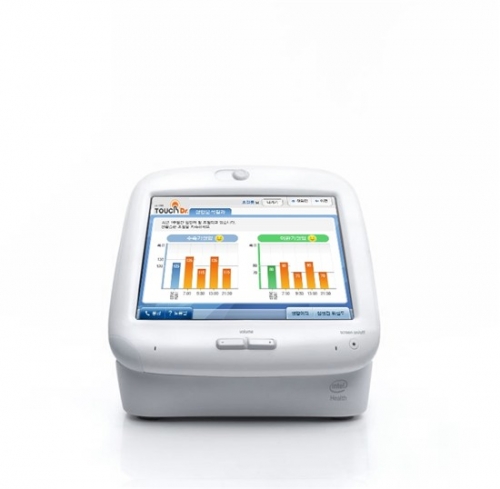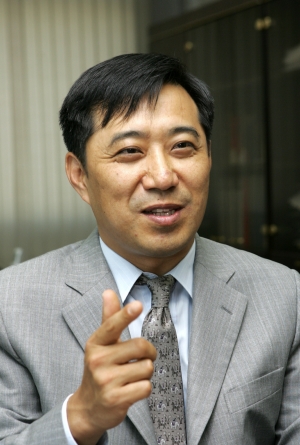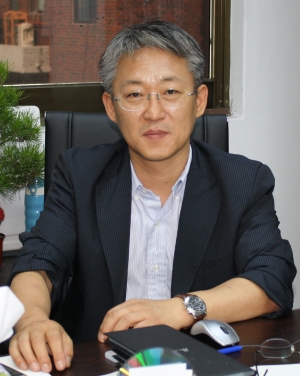Innovative, cutting-edge services spawn new markets. Medical information technology is one of those examples. Many Korean companies are now entering into the medical information service with new advanced technology. Although there are still many limitations in laws and regulations to expand its market, many companies are already working on new u-Health services to take a big share of the u-Health market in the future. As medical information services are separated into new markets, competition is heating up and u-Health service is entering the spotlight.
Recently, IT service companies in the u-Health industry are making great developments and showing a lot of improvements in technology. LG CNS has launched the Touch Doctor Service. Samsung SDS and many medical information-related companies like Hyundai Information Technology and Pyognhwa iS are also working on new medical information services which have great potential to succeed in the global u-Health market.
u-Health information technology is getting a lot of attention overseas. Since many countries are becoming aged societies, more convenient and faster medical services are needed and related markets are expanding. While chronic diseases are increasing, interests in health, vaccines, health care, and medical services are growing. To meet the global demand, Korean companies are accelerating their business activities in the medical information service market.

LG CNS Makes Strides into u-Health with Touch Doctor Wide
Among Korean medical information technology companies, LG CNS stands out with its home care service called Touch Doctor Wide. Touch Doctor is a customized medical measurement and monitoring system which is connected to the network. Based on the data collected from the system, users can talk with a health manager at the Health Management Center. The services provide medical consulting, health programs, and hospital affiliated services. Samsung is currently working with Gachon University of Medicine and Science for u-Healthcare services. Samsung SDS is also researching biometrics to study numerous genetic information process technologies. Using computers and software, an enormous amount of genetic information is analyzed to be applied in genetic engineering. For the research, Samsung SDS is planning to build a high-tech IT environment based on cloud computing.
Because the u-Health service industry has great potential in the overseas market, the government needs to step up and support it. However, the service must become more refined in order to be successful in the overseas market. There are still a few problems to solve. The companies have to create a business model by working with other industries and the government should ease regulations to help the industry. With a high synergy effect, projects like u-City construction could be national projects to lead the u-Health market in the world market.

LG Dacom’s TV Doctor Service Brings the Hospital to You
It is not easy to guess how far LG Dacom will go in the matured era of wireless and wired broadband that links every corner of Korean society on the Internet. The field of u-Healthcare is one in which LG Dacom has started investing assets to compete with its rivals who see it as cash cow in the future. Market players expect that when society is connected on the Internet, the volume of u-Healthcare utilized will be expanded as in the case of Google. u-Healthcare is a new medical service in which patients and non-patients achieve every necessary step for their reservation, prescription, and medical treatment. LG Dacom is capable of running the new business as a competitive broadband network service provider.
The TV Doctor Service is one that LG Dacom has put together with the National Information Society Agency on a trial basis. NISA has sponsored the private sectors to test a medical service that should be carried on in broadband networks. The test will provide video programs online, wireless or wired, so that people can get information about their diseases, health consultations, remote prescriptions and maps to hospitals nearest to patients. The remote treatment and consultation service, for example, will be provided for 200 houses across the country in a bid to test them. In this program, four leading hospitals, including Seoul National University Hospital, have shown their willingness to upgrade the existing medical system in the near future. They will issue prescriptions through computerized networks with the help of remote services to patients who are accustomed to the Internet. Doctors can talk with patients through video phones, with no need for either of them to spend time and energy with offline consultations. “Cutting-edge broadband networks enable us to serve patients in a better way, fast and efficiently,” said Director Ahn Sung-joon of LG Dacom.
A map search service provides easy access to information on the locations of hospitals which are the closest to individuals. Patients can also get information on what specialty each hospital has and on the reputations of doctors. The disease information service covers the twelve chronic diseases Koreans suffer from most frequently. It also carries the symptoms of the diseases and the best manner in which to treat them. The service provides checklists for individuals who want to know about their treatment state.
People can get information about health from a Health VOD service available from LG Dacom. Among the various programs included are medical dramas, lectures, exercises, and common sense.
Director Ahn addressed the reason that LG Dacom made inroads into u-Health by saying that broadband network providers and IPTV companies had the best chance to provide new platforms for medical suppliers and consumers. “Cutting-edge information technology opened new doors to the health field,” said Ahn. “LG Dacom would spearhead the related industry.” LG Dacom’s advance into u-Health should broaden the horizon of the existing health care system from hospitals to the houses in which patients stay and get proper information and diagnosis online from doctors. This means patients do not have to go to see their doctors in person. It should make it faster and more efficient from both the patients' and doctors' perspectives. Also LG Dacom’s service can help patients get treatment 24 hours a day because patients can get in touch with doctors online at any time.
LG Dacom sees the future of TV Doctor Programs bright because they are really different from what patients have seen so far. They are bilateral, meaning subscribers can talk with doctors online, and they can talk back. They focus on consumers. “The TV Doctor will change the whole aspect of existing hospitals which are notorious for their bureaucratic processes and lazy service,” said director Ahn. “In order to get TV Doctor in the right direction, some legal arrangements and revisions are needed.” If LG Dacom comes up with desirable output from the test service, it can play a main role in the u-Health era which will begin as information and technology based on broadband networks get into full gear.
IPTV and Its Role in the Ubiquitous Healthcare Information System

Kyeongwon U-Globe Ubiquitous Healthcare Information System collaborated with Konkuk University Hospital since 2009 and provided the Hygeian Ultimate Service to its patients. Its impact was huge enough to make a big jump toward medical advances. CEO Cha Joo-hak of Kyeongwon U-Globe has recently gotten contact from a medical equipment supplier in California who showed a high interest in future collaboration to supply ubiquitous healthcare information systems in local doctor's clinics. “A few plastic surgeons were in search of a monitoring system where they could promise an extra care after a surgery,” commented James Ko. What does this signify about IPTV and the future u-healthcare system
“The basic function of the Ubiquitous Healthcare Information System (UHIS) is to receive appropriate and accurate data from various devices for vital signs, physiological status and environmental data and to respond in real time or periodically to a user in need of care by transmitting a medical consultation. The major benefit from adopting ubiquitous technologies in healthcare services is to improve healthcare communications, and hence to reduce costs. In other words, unnecessary inefficiencies and undesired bottlenecks in the traditional system are eliminated or minimized,” President Cha explained.
“For the purpose of achieving the end of the UHIS, a new and low-cost method of delivering digital content is required. A new technology called Internet Protocol-based Television (IPTV) may be an answer to this request. As the name suggests, IPTV, called Telco TV or Broadband TV, describes a mechanism for transporting a stream of video content over a network that uses the IP networking protocol. The benefits of this mechanism of delivering TV signals vary from increased support for interactivity to faster channel changing times and improved interoperability with existing home networks.”
The official definition approved by the International Telecommunication Union focus group on IPTV (ITU-T FG IPTV) is as follows. IPTV is defined as a multimedia service such as television, video, audio, text, graphics and data delivered over IP based networks managed to provide the required level of quality of service and experience, security, interactivity and reliability.
IPTV has a number of features. It has support for interactive TV, time shifting, personalization, low bandwidth requirements, and accessibility on multiple devices. The two-way capabilities of IPTV systems allow service providers to deliver interactive TV applications. The types of services delivered via an IPTV service can include standard live TV, high definition TV (HDTV), interactive games, and high speed Internet browsing. IPTV, in combination with a digital video recorder, permits the time shifting of programming content - a mechanism for recording and storing IPTV content for later viewing. An end-to-end IPTV system supports bidirectional communications and allows end users to personalize their TV viewing habits by allowing them to decide what they want to watch and when they want to watch it.
Instead of delivering every channel to every end user, IPTV technologies allows service providers to only stream the channel that the end user has requested. This attractive feature allows network operators to conserve bandwidth on their networks. Viewing of IPTV content is not limited to televisions. Consumers often use their PCs and mobile devices to access IPTV services.
CEO Cha Joo-hak concluded, “IPTV with the above-mentioned features provides the user interface required in u-Healthcare, which will help popularize the service. With a remote control, a user can connect in easy, secure and interactive ways to a u-Healthcare Service Channel, record the personal information of his medical content and consultation in his local storage and replay it whenever he wants.”


